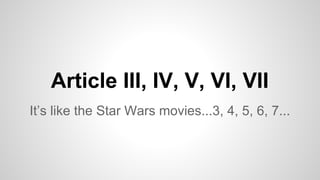The other articles
- 1. Article III, IV, V, VI, VII ItĄŊs like the Star Wars movies...3, 4, 5, 6, 7...
- 2. Article III--The Judicial Branch Ąņ Establishes a Supreme Court and lower courts Ąņ Job is to interpret the laws and be sure that they align with the Constitution. Ąņ Justices are appointed by the President and confirmed by the Senate Ąņ Term is for life! Ą°hold their offices during good behavior.Ąą
- 3. The Supreme Court: Hears legal cases about Treaties Ambassadors, Ministers and Counsels* Maritime disputes Between states* Between citizens of different states
- 4. About trials in general Ąņ Must be trial by jury Ąņ Must be in the state where the crime is committed Ąņ Treason: Giving aid and comfort to the enemy OR levying war against the US Ąð Requires two witnesses against to be guilty Ąð Congress sets the punishment
- 6. L to R: (top) Sonia Sotomayor (60), Stephen G. Breyer (76), Samuel Alito (64), Elana Kagan (54) (seated) Clarence Thomas 66), Antonin Scalia 78), John Roberts (Chief Justice) (59) Anthony Kennedy (78), Ruth Bader Ginsburg (81)
- 7. States must follow the Constitution; States will hand over criminals to each other; Congress makes new states; All states will have Republican forms of government Article IV
- 8. Amendments to the Constitution: if ? of both Houses of Congress agree, or if ? of states call for a convention, AND afterward, ? of states (legislatures or conventions) approve, the Amendment is adopted. Article V
- 9. All old debts are still valid; the Constitution is the supreme law of the land and all officers of the government must swear an oath to uphold it. Oh, and no religious test may be used to hold office. Article VI
- 10. 9 states are needed to ratify this Constitution. Article VII










